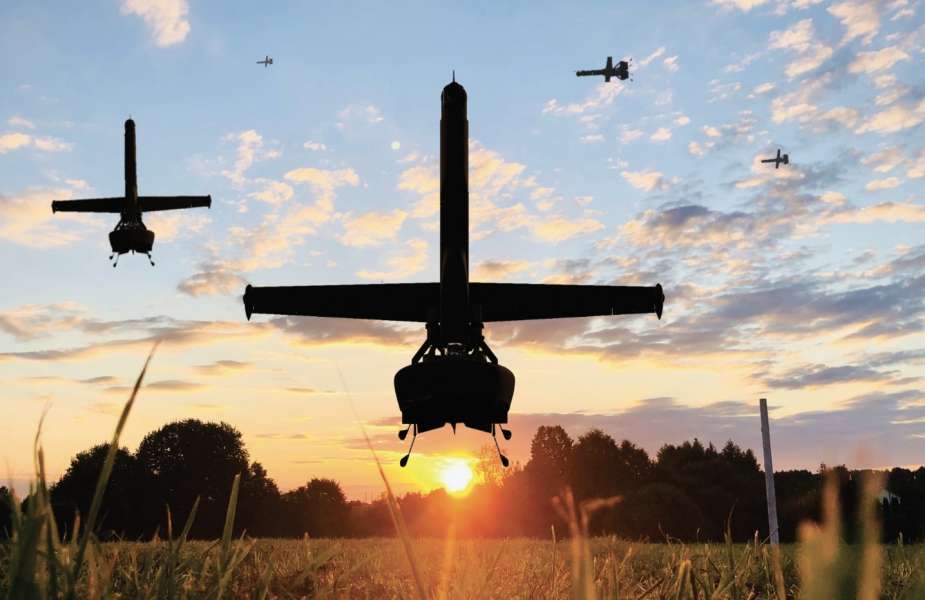Breaking news
Shield AI's V-Bat Teams lead the way in US Army's future drone strategy.
California-based defense technology company Shield AI introduced its new drone grouping technology, called V-Bat Teams, earlier this week. Developed in collaboration with the Air Force's AFWERX innovation unit, the technology is considered a major advancement in autonomous drones and is receiving attention for its potential applications in the Replicator program of the United States Department of Defense.
Follow Air Recognition on Google News at this link
 California-based defense technology company Shield AI introduced its new drone grouping technology, called V-Bat Teams (Picture source: Shield AI)
California-based defense technology company Shield AI introduced its new drone grouping technology, called V-Bat Teams (Picture source: Shield AI)
Shield AI initially conducted experiments involving V-Bat aircraft and artificial intelligence (AI) with AFWERX, culminating in a successful demonstration this summer. At the heart of the V-Bat teams is the company's cutting-edge AI software, called Hivemind, designed to enable drones to operate autonomously in high-risk environments without GPS guidance or communications.
In an interview at the Association of the United States Army annual conference, Shield AI co-founder and president Brandon Tseng said V-Bat teams are designed to operate with minimal human intervention. Humans would only specify the target or mission, and the V-Bats would proceed autonomously, alerting operators only if they encounter situations requiring human attention.
The V-Bat teams' first flight took place in April 2023, followed by an AFWERX demonstration in June that showed how Hivemind could autonomously control a trio of V-Bats to monitor and conduct surveillance on simulated wildfires. Currently, V-Bat teams consist of four drones, but Shield AI aims to double that number each year.
Northrop Grumman is teamed with Shield AI, designer, and manufacturer of the V-BAT platform, to provide best-in-class solutions for an expeditionary vertical takeoff and landing (VTOL) UAS, capable of persistent aerial reconnaissance for U.S. Army Brigade Combat Teams, Special Forces, and Ranger battalions. As a Future Vertical Lift program, the FTUAS is the Army’s first VTOL unmanned aircraft modernization effort.
The V-BAT, with its innovative, near-zero footprint vertical take-off and landing (VTOL) and long-endurance capabilities, is unlike any UAS on the market. Propelled by a single, ducted, thrust-vectored fan, it takes off and lands in the style of a SpaceX rocket. Its fully operational logistical footprint fits into the bed of a pickup truck or inside a Blackhawk helicopter, significantly reducing the total cost of capability. U.S. and international customers view the V-BAT as a flexible, cost-efficient platform capable of performing Group 2 UAS to Group 5 UAS missions and beyond.
Earlier versions of the V-BAT have supported operations for the U.S. Navy and Marine Corps since 2016. The new enhanced V-BAT is simple to operate, has increased power, a reduced logistics size, and the capacity to carry a range of interchangeable payloads, including electro-optical/infra-red, synthetic aperture radar, and EW systems, offering long-term adaptability and life cycle management.
While the Hivemind software is capable of managing multiple V-Bats, operational logistical constraints pose a limitation, particularly launching and landing multiple drones simultaneously. Tseng stressed that unlike drones used at festivals or celebratory events, which are "fragile and stupid drones", V-Bat teams are smart and secure, designed to resist jamming and other interference.
Initially, V-Bat teams will focus on maritime domain awareness missions. However, their role may ultimately expand to include suppression of enemy air defenses, strike operations, escort missions, and logistical operations. Shield AI is also partnered with Northrop Grumman to offer best-in-class solutions for vertical takeoff and landing (VTOL) unmanned aircraft systems.
As the Pentagon seeks to deploy thousands of autonomous drones to counter emerging threats, Shield AI's V-Bat teams offer a glimpse into the future of autonomous cluster technology in defense. With the ability to operate with minimal human intervention and robust resistance to external disruptions, V-Bat teams mark a significant step in the path toward truly autonomous military operations.



















